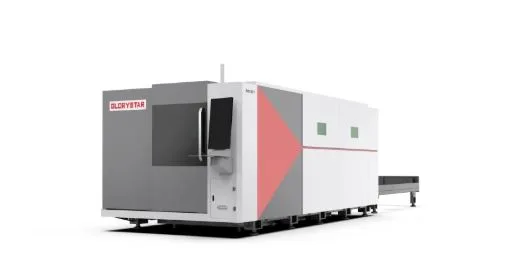Understanding Fiber Laser Cutting Machines vs CO2 Laser Cutters
Laser cutting has become one of the most efficient and precise methods for shaping materials. By focusing a high-powered laser beam on a workpiece, the material is melted, vaporized, or burned, and high-speed airflow removes the molten portion to create a clean cut. This technique is widely used in various manufacturing industries.
A Fiber Laser Cutting Machine and a CO2 laser cutter differ mainly in the type of laser source they use. Understanding these differences can help manufacturers choose the right machine for their specific needs.
What is a Fiber Laser Cutting Machine and How It Works
A Fiber Laser Cutting Machine uses a fiber laser as its source. This type of laser generates a high-energy-density beam that is tightly focused on the surface of the material. The focused laser spot can instantly melt and vaporize the target area. Its position is precisely controlled by a numerical control system, enabling automated and highly accurate cutting.
Fiber laser machines are particularly suitable for cutting metals of different thicknesses. They deliver high precision, making them ideal for intricate designs and detailed patterns. In addition, fiber laser machines generally operate faster, consume less energy, and require lower maintenance compared to traditional CO2 laser cutters.
What is a CO2 Laser Cutter and How It Works
A CO2 laser cutter relies on carbon dioxide gas as the active medium. The laser emits a beam with a wavelength of approximately 10.6 micrometers, which melts and vaporizes the targeted material. Precision is achieved by controlling the laser beam’s position through mechanical and optical systems.
CO2 laser cutters are versatile and effective for cutting non-metallic materials such as wood, acrylic, plexiglass, and PP. They can handle thicknesses up to 20mm for some non-metal materials, making them suitable for small-scale production and prototyping. However, CO2 lasers usually have lower energy efficiency and require more frequent maintenance than fiber laser machines.
Key Differences Between Fiber Laser Cutting Machines and CO2 Laser Cutters
- Laser Source and Transmission: Fiber laser machines generate light through diode pumping and transmit it via fiber optic cables, while CO2 lasers produce light by exciting CO2 and nitrogen gas and transmit the beam through mirrors.
- Wavelength: Fiber lasers operate in the near-infrared range at around 1 micrometer, whereas CO2 lasers operate at a longer infrared wavelength of 10.6 micrometers.
- Precision and Cutting Capability: Fiber laser machines offer higher precision and are ideal for metal cutting, including detailed patterns. CO2 lasers work well on non-metal materials but have limitations when cutting fine metal details.
- Operating Costs and Efficiency: Fiber laser machines are more energy-efficient, with higher photoelectric conversion rates (around 30%) compared to CO2 lasers (around 10%). They also require less maintenance. CO2 lasers have higher operating costs due to gas consumption and more frequent maintenance needs.
- Applications: Fiber laser machines excel in sheet metal processing, high-precision metal cutting, and even 3D cutting using mechanical arms. CO2 lasers are best suited for non-metal applications, providing versatility for materials like wood, acrylic, and plastics.
- Speed and Performance: Fiber laser machines typically offer faster cutting speeds, especially for metal materials, making them ideal for industrial production lines. CO2 lasers tend to be slower in comparison, particularly when handling metal.
Choosing the Right Machine
For manufacturers focused on metal processing, a Fiber Laser Cutting Machine is the optimal choice. It combines precision, speed, and energy efficiency while minimizing maintenance requirements. On the other hand, if your production involves non-metal materials or prototyping with versatile materials, a CO2 laser cutter may be the better option.
In summary, a Fiber Laser Cutting Machine is the best solution for fast and precise metal cutting, while CO2 lasers are ideal for a variety of non-metal materials. Your choice should align with the types of materials you work with, production speed, and budget considerations.





